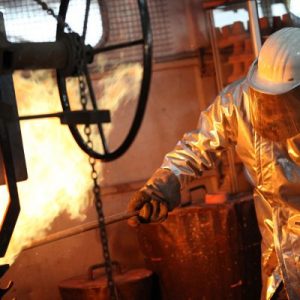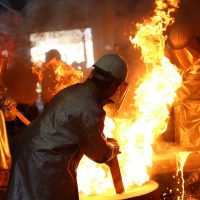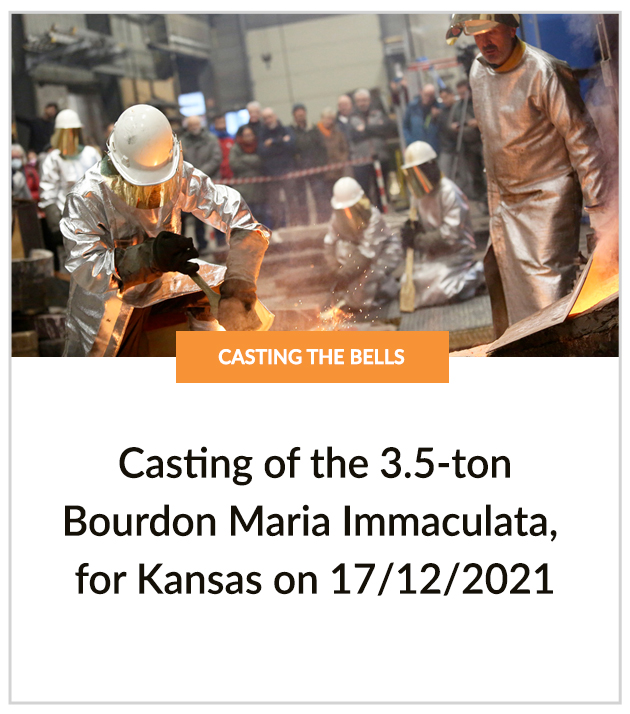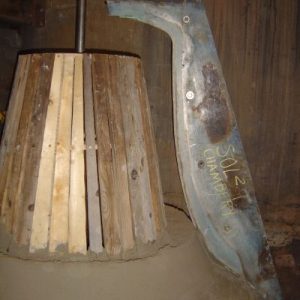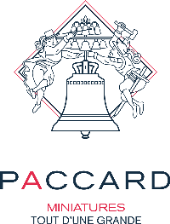
Cast bronze bells
"For us, each bell tells a story: yours."
— Philippe Paccard, Executive Director
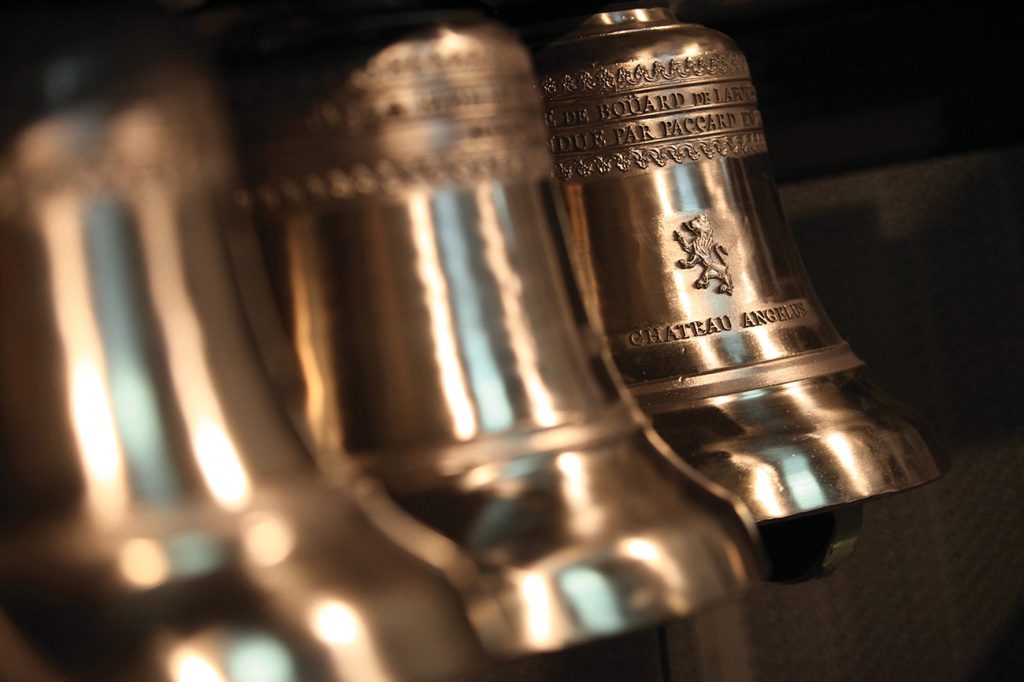
Regardless of your cast bronze bell project, whether it requires a single bell, a peal, chime, carillon, or Ars Sonora®, with musical and aesthetic craftsmanship, we partner with you to design, plan, and install a bell instrument of the highest quality and lasting value.
The inspiring sound of PACCARD bells ring from nearly 125,000 installations around the world. Known for their artistry and harmonic perfection, PACCARD bells have a well-deserved reputation as the Bell Stradivarius. The PACCARD Foundry produces a wide range of bells, including bourdon bells for cathedrals, church bells, mission bells, house bells, sacristy bells, bells for cultural or sporting events, carillons, Ars Sonora (musical sculptures), and personalized miniature bells.
Bells have existed for thousands of years. They have been a part of all civilizations and come in various shapes and materials. The earliest traces of bells began appearing in China around 2000 B.C. Early Christians adopted bells as symbols for calls to worship and messianic gatherings; the term “Signum” (which gave rise to the old French word “sain,” meaning bell) reflects this significance.
Our bells are made of bronze, composed of 78% copper and 22% tin, and are noted for their exquisite designs. They feature decorative friezes showcasing religious or pastoral themes. We can replicate the unique brand and inscriptions of your organization, as well as the effigies of saints and other religious symbols from our collection of approximately 5,000 engravings.

Bells can be smooth cast or embellished. Our artisans use the meticulous, hand-crafted process of lost-wax casting. With a library of more than 5,000 etching patterns, we create beautiful custom designs that ensure your organization’s legacy.
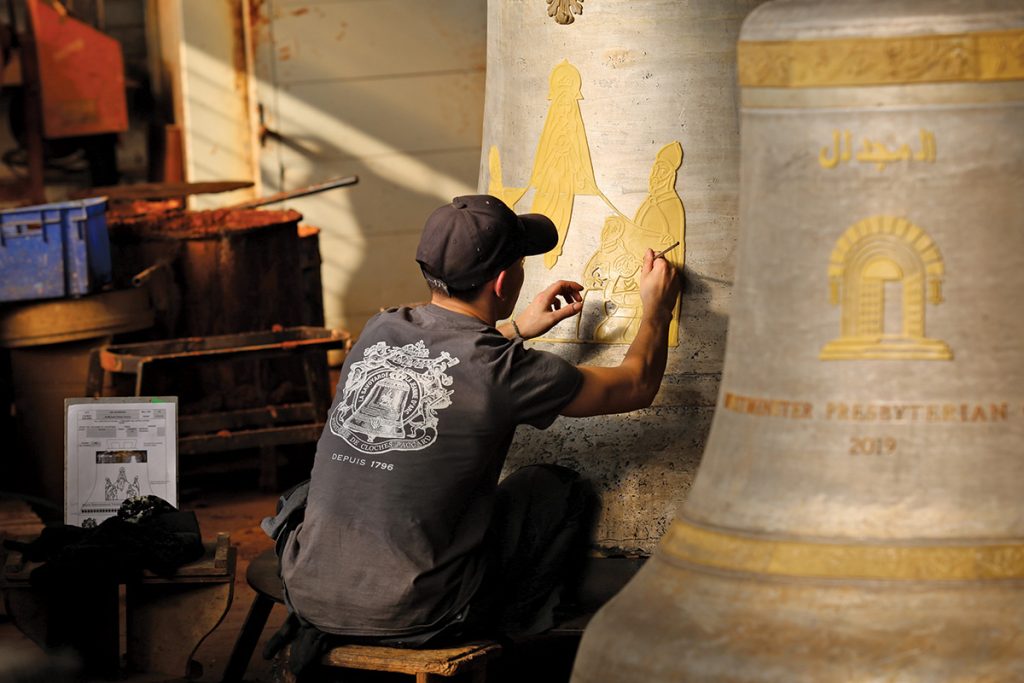
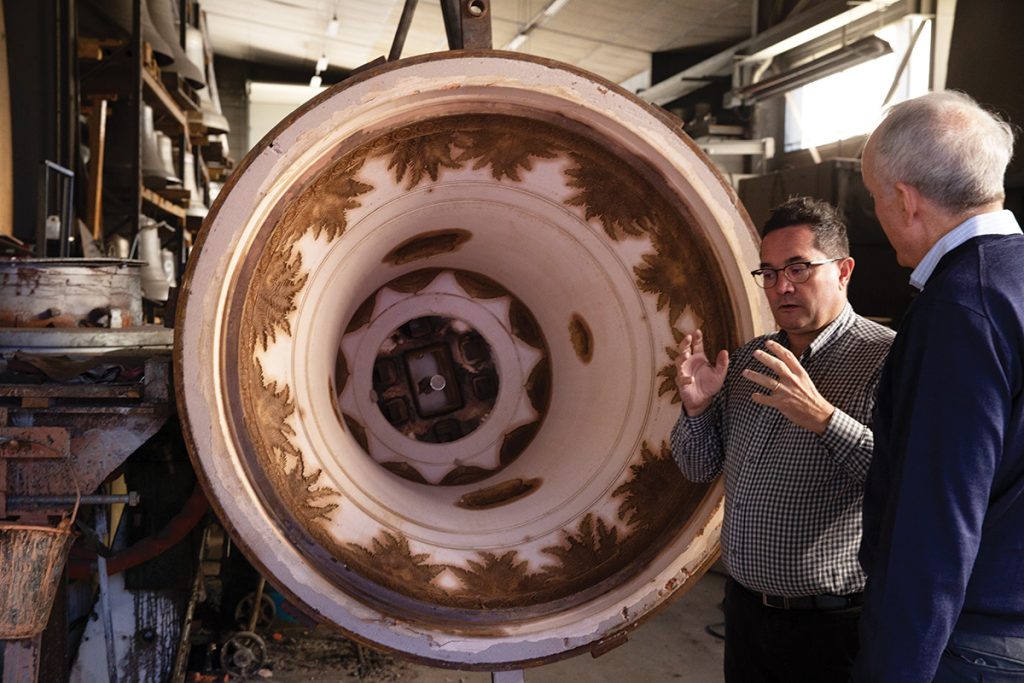
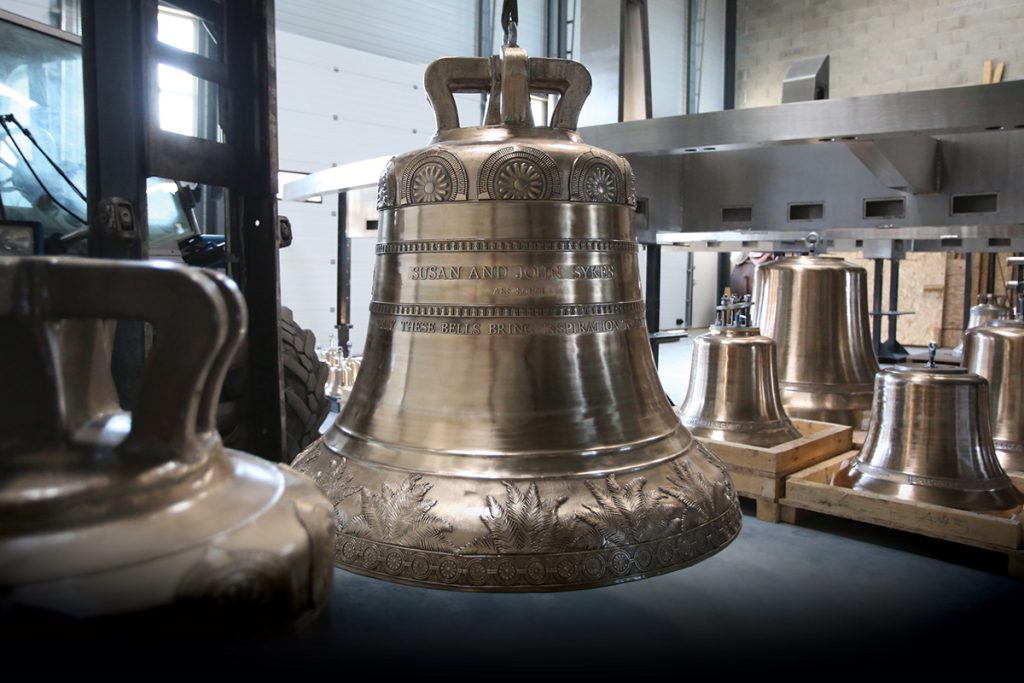
In addition to single cast bells, PACCARD is also the world specialist in producing multiple bells, which include:
> Peal Of Swinging Bells: Comprised of one to eight bells, a peal of swinging bells is a popular choice for churches, colleges, and town squares.
> Cast Bell Chimes: Chimes consisting up to 22 bells are usually arranged in a diatonic scale similar to the arrangement of piano keys.
> Carillons: Each custom carillon consists of 23 or more bells, played from a keyboard console linked directly to the bell clappers, allowing for full musical expression. Fully automated operation is also available.
> Ars Sonora: Ars Sonora® is an artistic musical sculpture designed to enhance the beauty of the bell. The Ars Sonora’s bells are visible and fully contribute to the design and aesthetics of the sculpture.

At the heart of the bell-making process lies the core, an essential component of the mold that shapes the interior of the bell itself. Once casting is complete, this core will completely occupy the inside of the bell, creating its unique acoustics. Crafted with a thoughtful arrangement of bricks, securely bound with wire and enveloped in clay, the core embodies both ingenuity and skill, setting the foundation for the bell’s beauty.
Next, we have the false bell, an exciting element of the mold made from a crumbly earth that mirrors the future bell in both size and thickness. Temporarily standing in place of the final product, it serves as a canvas for intricate decorations and writings, which are artistically rendered in wax and raised relief, known as the lost-wax technique. A fascinating aspect of the process, these engravings become a cherished part of each bell’s identity. When designing the inscriptions, simplicity is key: we believe that understated elegance truly enhances the character of the bells. While there are no strict guidelines for the text, some common elements often include the bell’s name, mentions of the reigning Pope, the bishop of the diocese, the parish priest, or the mayor. Additionally, the names of the main donors can be included, which not only fosters a sense of community but might also inspire further support for the project.
Finally, we arrive at the cope, the outer layer of the mold that safeguards the false bell. Constructed from earth and layered meticulously, it begins with a delicate, almost fluid, soil known as “polishing powder” for the initial strata. The process then shifts to using a sturdier clay interwoven with hemp, providing a robust structure that enhances the overall integrity of the mold. Once the cope is complete, it’s fired, allowing the wax decorations from the false bell to melt away, leaving behind magnificent counter-relief impressions that will forever be etched into the cope. This transformative journey from earth to bell is not just a testament to craftsmanship, but a celebration of artistry and tradition that resonates through the ages. Each bell tells its own story, inviting us to appreciate its beauty and the care taken in its creation.
The false bell, which serves as a temporary replacement for the future bronze bell, is only needed to create the cope. A hoist lifts the cope, and then the false bell is broken. The cope is then placed back on the core. A carefully executed gap remains between the two parts of the mold. A precise mixture of molten metal is poured into this gap during the Casting.
In the past, when the residents of Annecy saw a glow in the northern sky at dusk, it signaled that there would be a bell casting in the morning. The flames often reached several meters above the chimney, showering thousands of sparks into the air. Many townspeople have attended this event at least once. The Casting originally took place at the wood oven in Annecy-le-Vieux, where the PACCARD Foundry operated until 1989. Today, in Sevrier, modern workshops utilize gas ovens.
A bell casting is a moving and unforgettable spectacle! It is a magical moment when, on the founder’s cue, the workers unleash the molten metal, which bubbles and flows in streams of fire, rushing to fill the mold. The process is rapid, almost like a flash. Within minutes, it is all over. Meanwhile, the priest, who blessed the metal before it is removed from the furnace, gives thanks to God for His blessings in the silence of the crowd.
To attend a bell casting, contact us. With PACCARD Museum, it is possible!
Bells have been existing for thousands of years. The Bible, the oldest book in the world, already mentioned it. It is present in all civilisations. Of different shapes and materials, the first traces date back to 4000 B.C. The bronze bell first appeared in China around 2000 B.C. The first Christians made it a symbol of call and messianic assembly : the Signum (signal which, in old French, gave the word « sain », synonym with bell).
Our bells are made of bronze (78 % copper and 22 % tin) and are distinguished by their very beautiful presentation. They are decorated with friezes which represent religious or bucolic patterns. We reproduce the specific writings of each community, as well as the effigies of saints and other religious patterns that may be requested and that are part of our collection (about 5,000 engravings).
PACCARD Foundry produced bourdons for cathedrals, church bells, mission bells, house bells, sacristy bells, bells for cultural or sports events, carillons, musical sculptures, but also personalised miniature bells… All the applications will be considered !
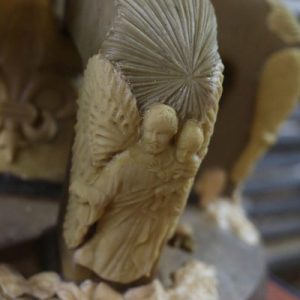

This part of the mould, made of friable earth, represents the bell itself, in whose place it temporarily stands. It therefore has the same dimensions, the same thickness as the future bell. On this false bell is placed the ornementation and the writings. These decorations are made of wax and in relief.
The writings are cast at the same time as the bell. Thus the imprints are placed in the mould, nearly in the beginning of the manufacturing. This is the lost wax process, the writings and decorations are placed on the false bell and engraved in relief, they will then be in negative inside the mould.
For the beauty of the bells, we recommend simple writings. The sobriety is the main quality of the epigraphic style. There are no absolute rules for the composition of the text. The main elements may be : the name of the bell depending on the case, the indication of the reigning Pope, of the bishop of the diocese, the parish priest or the mayor of the town (in particular if this one takes part in the expenditure). In addition, the names of the Godfather and Godmother or the names of the main donors are sometimes added, which can encourage the launch of a subscription.
It is the outside part of the mould, the part that will cover the false bell. It is also made of earth and formed with successive stratums. The first stratums are got with a very light, nearly fluid soil, which is called « polishing powder ». The manufacturing of the cope is then made with thicker clay, reinforced with hemp, which ensure a greater solidity to the whole.
The mould is then fired, which melts the wax decorations placed before and whose imprits remain counter-relief and upside down in the cope.
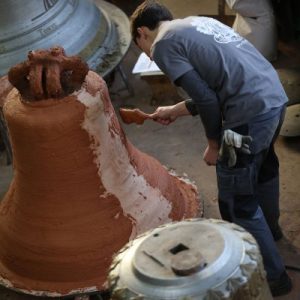

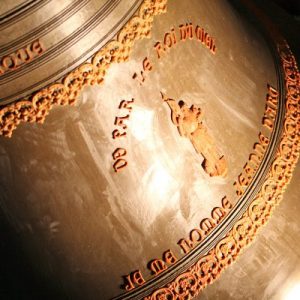
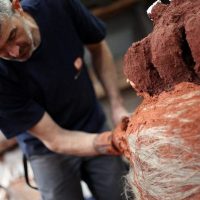
The mould is finished. So, will we execute immediately the casting ? Not yet ! This is where the unmoulding takes place. The false bell, as we said, temporarily replaces the future bronze bell ; it is then only useful for the manufacturing of the cope. The time has come to remove it. Using a hoist the cope is lifted and the false bell is broken. The cope is then placed back on the core. Between these two parts of the mould and thanks to a meticulously established impact, its remains a gap made by the disappearance of the false bell. In this gap is cast the molten metal.
In the past, when the inhabitants of Annecy saw a glow at nightfall towards the North, it was the signal that the next morning there would be a bell casting. The flame sometimes rose several metres above the top of the chimney, throwing off thousands of sparks. There are hardly any of them who have not come, at least once, to attend this operation. It was the time of the wood oven, in Annecy-le-Vieux, where the PACCARD Foundry was located until 1989. Today, in Sevrier, in modernised workshops, gas ovens were used.
A bell casting : moving and unforgettable show ! A really spectacular and almost magical moment, when, on the orders of the founder, the workers give free rein to the molten metal, which comes out bubbling, runs in streams of fire and rushes with whistlings into the moulds which it fills.
It is all really fast, almost like a flash. In a few minutes all is finished, but it is enough, because the air is too hot, the atmosphere has become unbreathable and we hasten to ventilate. During this time, the priest, who has already blessed the metal before its come out of the furnace, give thanks to God for the true thanksgivings, in the silence of all the people.
Attend a bell casting, contact us. With PACCARD Museum, it is possible !
